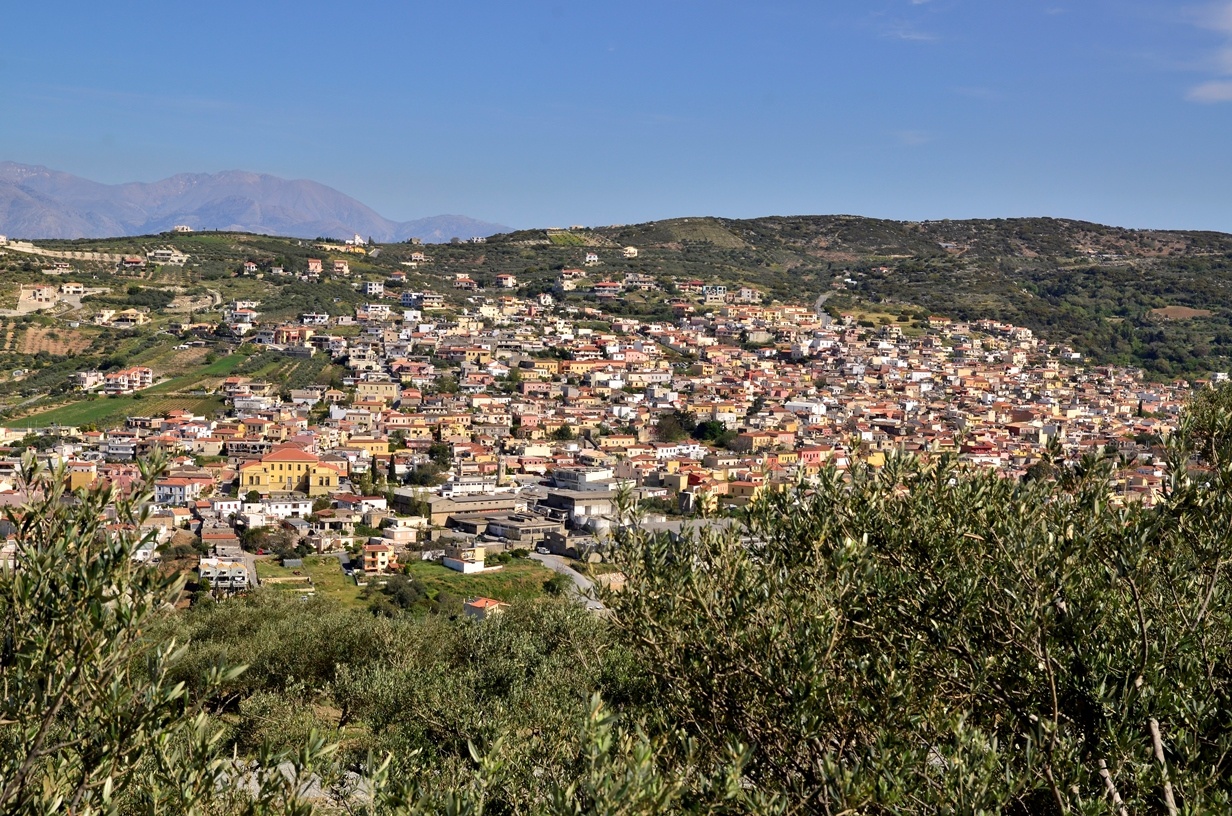
THE SEAT OF THE MUNICIPAL UNIT OF ARCHANES
Distance from Heraklion: 15.7 km.
You are in Archanes, the most charming hamlet of Crete. Observing it from above, one can fully recognise why this land has been inhabited since late Neolithic times. To the west looms sacred Mt. Juktas, surrounded by hills with numerous water springs.
Rich water springs fed the Kairatos River (present-day Katsampadianos), which irrigated the fertile valley that connected Archanes with the famous Knossos Palace and ended at the north coast of Heraklion.
The lush Cretan landscape we see today embracing the hamlet, teeming with vineyards, olive groves and cypresses, must be quite similar to that in Minoan times. When the Ottomans, after 22 years’ siege, managed to conquer the Venetian Chandax (Heraklion) in 1669, they gave the city as a gift to A. Baroci, the person who had betrayed it. Archanes became the stronghold of the rebels/guerrilla fighters. In the times of the Cretan State, the city flourished: wine, raisins and olive oil were exported and brought wealth to the city.
The well-to-do Archanians, wanting to express their love and desire to unite with Greece, built houses in the neoclassical style. Their mansion facades adopted an architectural trend imported from liberated Greece. This is how a unique hamlet of architectural interest was created, which has been preserved in its entirety. Extensive pedestrianisation, picturesque cobblestone lanes, lamp posts and beautifully restored mansions give visitors to Archanes the opportunity to travel back in time. Christian churches decorated with murals coexist with fountains and wonderful buildings from the Ottoman era, the best one among them being Mustafa Naili Pasha’s residence, with fountains and gardens. On the north side of the valley is the quaint gorge named Paradeisi (small Paradise), which the Ottomans called Akarsular Dag (Mountain of the Running Waters).
Within the same gorge, at Pelekita location, there is a water spring; in 1628, Fransesco Morosini channelled its waters to supply Heraklion. The spring is dry today because of water drilling projects in the area.
‘Acharna’
The main hamlet is today called Epano Acharnes and stands separate from the quarter of Kato Archanes, which is one km to the north. Archanes has preserved its ancient Greek name, which can be found on a 5th century B.C. inscription. It is an alliance treaty between Knossos and Tylissos, and one of the provisions mentioned, “Archos will have the sanctuary in Acharna”. Archos was a local hero worshipped in Archanes. Archaeological testimony confirms the village’s inhabitation in prehistoric times and throughout history.
Present-day Archanes
Where the old vineyards that made Archanes famous for the rozaki and sultana grapes used to be in the past, there stretch today extensive vineyards producing excellent table grapes that are mainly consumed in European markets. Other important products of Archanes include raisins, wine and olive oil.
The hamlet itself is a particularly lively community. Pretty hostels and quaint taverns and cafés serving traditional dishes are poles of attraction for visitors. Discover the small shops still operating in the ‘old market’ (palia agora) lanes; you will find plenty of handcrafted items and local products sold by local entrepreneurs.
In ancient times
The palace complex of Archanes was first built in the beginning of the second millennium B.C. along with the first palaces of Knossos, Phaistos and Malia. S. Xanthoudakis was the first to point out the importance of Archanes in 1912. It was A. Evans, however, who discerned the palatial character of the ruins. In 1922 he started excavations that brought to light part of the palace. Based on the Victorian understanding of his times, Evans put forth the theory of the summer palace of the royals of Knossos at Archanes.
In 1964 archaeologists Giannis and Effie Sakellarakis excavated Tourkogeitonia and brought to light part of the palace structure. Quite possibly three stories high, it was luxurious and magnificent. The floors were covered with marble or slate and the walls with impressive murals.
Archanes Archaeological Sites
The Minoan city of Archanes and its palace complex was discovered in a small, closed valley, 15km from Knossos. Evidence supporting the oldest human presence in the region comes from the stone tools and a burial dating to the Late and Final Neolithic Periods (5th – 4th millennium B.C.).
In the Pre-Palatial period (3000-1900 B.C.), according to architectural relics found near the late Minoan palace complex and ceramic finds, there used to be a proto-Minoan settlement. The most important evidence, however, comes from the burial monuments of the necropolis discovered at Fourni. The various precious artefacts, such as ceramics, seals, Cycladic statuettes, golden jewellery, Egyptian scarabs, reflect the wealth of residents and an organised social life in contact with the outside world.
Life continued in Archanes in the Old-Palatial period (1900-1700 B.C.) and the hamlet developed into a significant Minoan community with a palace complex. Architectural relics lay beneath the palace building constructed at a later date; wonderful samples of Kamares ceramic ware have been found in Tourkogeitonia, while in nearby sites other town sectors have come to light, such as the theatre area, the underground water tank, the archives and the sanctuaries.
At Troula archaeological site a cochliarion (stone vessel used in rituals) has been found along with Mid-Minoan ceramics. Important information on the worship of the inhabitants is found at the sanctuaries of Archanes region. A peak sanctuary was established on the Psili Korfi (High Peak) of Mt. Juktas. Another very important sanctuary is the independent temple in Anemospilia, on the west side of the mountain.
The settlement flourished during the New Palatial Period (1700-1450 B.C.).
The excavated part of the brilliant palace centre at Archanes belongs to this period. Significant isolated residences or mansions were built in the surrounding area (Vitsila, Karnari, Chomatolakos, Xeri Kara, and Vathypetro). Around 1450 B.C. yet another major earthquake caused a lot of destruction throughout the island including Archanes.
Life in this location went on, nevertheless. The appearance of Mycenaeans on Crete did not lead to stagnation. On the contrary, a wealth of Mycenaean finds, both in the palace centre and the necropolis of Fourni, reflect continuous growth.
In historical times, various finds from Archanes and its broader region confirm its continued inhabitation during Geometric and Archaic years, while Mt. Juktas remained a place of worship. The first reference to the name ‘Archanes’ dates back to the Classical period. In 67 B.C. Crete became a Roman province, following its conquest by Metellus. Archanes then belonged to the Knossos territory. Architectural relics of residences and tombs confirm the presence of a settlement. There are few relics in Archanes from the Byzantine period. Rokkas Castle was built in the broader region (10th century A.D.). Some monuments from the Venetian period have been preserved in Archanes, such as the Morosini Fountain. The next conquest of Crete was by the Ottoman Turks (1669-1898), who also left their traces in Archanes, as the hamlet became one of the seats of Ottoman officials.
Excavations began the exploration of the Archanes region in the beginning of the 20th century, when St. Xanthoudidis indicated the presence of antiquities. Still, the person who started digging was A. Evans, who recognised the palace character of the Minoan complex. Evans’ research at the palace complex was continued by G. Sakellarakis in 1964. In 1965 the necropolis at Fourni was discovered and this further encouraged the search, while in 1966 the Archanes excavation was included in digs undertaken by the Archaeological Society.
MODERN HISTORY
CRETAN REVOLUTIONS
The town of Archanes was an important revolutionary centre of Eastern Crete during the 1897 Revolution. It was here that, as of February 1897, the Defense Committee of Archanes undertook the responsibility of coordinating military action in the broader region and Eastern Crete in general and faced major attacks by pro-Ottoman Cretans and the regular Ottoman army with remarkable bravery. In essence, the military part of the Cretan Question was decided in the region of Heraklion, centred round the town of Archanes, since the local geology makes it a natural fort, ideal, as proven later, to become the base of guerrilla fighters.
Indeed, the celebration of the 15th of March in 1897 (Commemorating the onset of the Greek Liberation War against the Ottomans) was grand, in this, first, and only, liberated part of Crete, i.e. Archanes, with no presence of Ottoman Occupation troops.
WORLD WAR II
The location of Archanes and the bravery and spirit of its inhabitants were the main factors for the active participation of the village in war events of the 20th century.
During the Battle of Crete (May 1941 - WWII) the Command Centre of the Greek Forces was established in Archanes, where a rudimentary military hospital was also established. In the first year of the Nazi Occupation, the first Intelligence task force on Crete was organised in Archanes, offering great services to the Resistance. The presence of the Occupation Forces was particularly strong in Archanes, since it was the seat of the Nazi Military Division.
SOME OF THE LOCAL SIGHTS:
Other infrastructure
- At Archanes there is a municipal open-air cinema operating in the summer; it is called ‘Paradeisos’ and it is part of a network of open-air summer cinemas of the Ministry of Culture. It is housed on a premises that blends in with the aesthetic character of the hamlet and the Greek tradition of open-air summer cinemas.
- The Centre for Environmental Education of Archanes (K.P.E.), which was founded to raise awareness and inform pupils, teachers and other social groups on local and global environmental issues. It has been in operation in Archanes since 2003 at a newly built complex and includes an organic olive grove, a vineyard and a botanical garden open to the public.
- Archanes is also the seat of Anaptyxiaki Irakleiou A.A.E. O.TA. (Heraklion Developmental Company, Local Authorities Organisation), the main aim of which is to support local authorities in their developmental role and developmental planning in the broader region.
- At Archanes there is a wide network of sports facilities, such as indoor gyms, stadiums and 5x5 football grounds, where the famous Juktas club is active with various sports academies.



 Epano Archanes
Epano Archanes